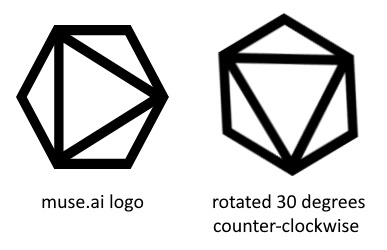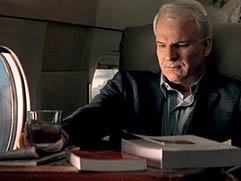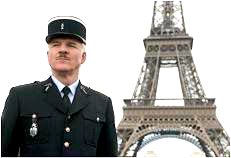
“She never looked up while her mind rotated the facts,
trying to see them from all sides, trying to piece them
together into theory. All she could think was that she
was flunking an IQ test.”
— Steve Martin, An Object of Beauty

“She never looked up while her mind rotated the facts,
trying to see them from all sides, trying to piece them
together into theory. All she could think was that she
was flunking an IQ test.”
— Steve Martin, An Object of Beauty
The Sternheim Portrait (For Harlan Kane)
From last night's 1:01 AM post —

Detail —

This portrait is of German playwright Carl Sternheim.
Steve Martin's version of Sternheim's 1910 play "The Underpants"
reportedly opened on November 3, 2006.
My own interests on that date lay elsewhere . . .
Related abstract art —
The phrase "ontological secret" is from 1927 —
" Beauty is thus 'a flashing of intelligence…
on a matter intelligibly arranged' or, as Maritain
adds in the 1927 edition of Art and Scholasticism ,
it is 'the ontological secret that [things] bear within
them[selves], their spiritual being, their operating
mystery.' "
— John G. Trapani, Jr., "'Radiance': The Metaphysical Foundations
of Maritain's Aesthetics," pp. 11-19 in Beauty, Art, and the Polis ,
ed. by Alice Ramos, publ. by American Maritain Association, 2000.
This 1927 phrase may be the source of McLuhan's 1944
"ontological secret" —

From a search in this journal for "Object of Beauty" —
“She never looked up while her mind rotated the facts,
trying to see them from all sides, trying to piece them
together into theory. All she could think was that she
was flunking an IQ test.”
— Steve Martin, An Object of Beauty
Steve Martin on his character Ray Porter
in the novella Shopgirl —

"He said, 'I wrote a piece of code
that they just can’t seem to do without.'
He was a symbolic logician. That was his career…."

"In short, he seeks to objectify crucial areas . . . ."
Or crucify objective areas.
The previous post quoted Holland Cotter's description of
the late Ellsworth Kelly as one who might have admired
"the anonymous role of the Romanesque church artist."
Work of a less anonymous sort was illustrated today by both
The New York Times and The Washington Post —
The Post 's remarks are of particular interest:
|
Philip Kennicott in The Washington Post , Dec. 28, 2015, “Sculpture for a Large Wall” consisted of 104 anodized aluminum panels, colored red, blue, yellow and black, and laid out on four long rows measuring 65 feet. Each panel seemed different from the next, subtle variations on the parallelogram, and yet together they also suggested a kind of language, or code, as if their shapes, colors and repeating patterns spelled out a basic computer language, or proto-digital message. The space in between the panels, and the shadows they cast on the wall, were also part of the effect, creating a contrast between the material substance of the art, and the cascading visual and mental ideas it conveyed. The piece was playful, and serious; present and absent; material and imaginary; visually bold and intellectually diaphanous. Often, with Kelly, you felt as if he offered up some ideal slice of the world, decontextualized almost to the point of absurdity. A single arc sliced out of a circle; a single perfect rectangle; one bold juxtaposition of color or shape. But when he allowed his work to encompass more complexity, to indulge a rhetoric of repetition, rhythmic contrasts, and multiple self-replicating ideas, it began to feel like language, or narrative. And this was always his best mode. |
Compare and contrast a 2010 work by Josefine Lyche —
Lyche's mirrors-on-the-wall installation is titled
"The 2×2 Case (Diamond Theorem)."
It is based on a smaller illustration of my own.
These variations also, as Kennicott said of Kelly's,
"suggested a kind of language, or code."
This may well be the source of their appeal for Lyche.
For me, however, such suggestiveness is irrelevant to the
significance of the variations in a larger purely geometric
context.
This context is of course quite inaccessible to most art
critics. Steve Martin, however, has a phrase that applies
to both Kelly's and Lyche's installations: "wall power."
See a post of Dec. 15, 2010.
Or: Entartete Kunst für Max .
Rail: You speak about your friendships with Mike Nichols and
Steve Martin, and I can understand the affinity in your sense
of timing, of knowing what to include and what to leave out.
Fischl: I had the great privilege the other night actually of
having dinner with Mike and Steve after looking at a workshop
that Steve and Edie Brickell are doing. Afterward we sat
around a table and Steve was asking for feedback because he is
still early in the process….
For Karl Pribram and Katherine Neville,
a sequel to this morning's Figural Processing —
See also Christmas 2013.
“… it offers the comfort of a community of other players
all stuck in the same hellish quagmire.”
— Review of a video game that was in the news today.
A tweet from the game’s developer last Christmas:

From this journal, also on Christmas Day last year:
“She never looked up while her mind rotated the facts,
trying to see them from all sides, trying to piece them
together into theory. All she could think was that she
was flunking an IQ test.”
— Steve Martin, An Object of Beauty

"She never looked up while her mind rotated the facts,
trying to see them from all sides, trying to piece them
together into theory. All she could think was that she
was flunking an IQ test."
— Steve Martin, An Object of Beauty
"So you should not feel so all alone…"
— Adapted song lyric
Google search result at 1 PM ET April 24, 2013:
New York Stage and Film 2013 Musicals – EPA – Playbill
www.playbill.com/jobs/find/job_detail/51922.html
14 hours ago – BRIGHT STAR
Casting: Howie Cherpakov
Music by Edie Brickell and Steve Martin
Lyrics by Edie Brickell Book by Steve Martin…
The musical is set in North Carolina.
From Howie Cherpakov:

From North Carolina:

Archibald Henderson monument, Chestnut Hill Cemetery, Salisbury, NC
Henderson died in 1963 on the Feast of St. Nicholas.
Related material: Santa vs. the Obelisk.
David Corfield discusses the philosophy of mathematics (Dec. 14) —
"It’s very tricky choosing a rich and interesting case study which is philosophically salient. To encourage the reader or listener to follow up the mathematics to understand what you’re saying, there must be a decent pay-off. An intricate twentieth century case study had better pack plenty of meta-mathematical punch."
Steve Martin discusses the philosophy of art (Dec. 5) —
 |
 |
CBS News interviews Martin at the Whitney Museum —
"We paused to consider the impact of a George Bellows fight scene. Martin said it has 'wall power.'
What does that phrase mean? 'How it holds the wall. How it feels when you're ten or 20 feet away from it. It really takes hold of the room.'"
See also Halloween 2010 —
From a post on the morning of November 22 —
Steve Martin on his character Ray Porter in the novella Shopgirl (published Oct. 11, 2000)—

"He said, 'I wrote a piece of code
that they just can’t seem to do without.'
He was a symbolic logician. That was his career…."
From more recent entertainment news — the new Disney film Tangled , and a related image—
This one ain't no shopgirl, Ray.
Related material — This journal on the date of the above Guardian story.
A reviewer says Steve Martin finds in his new novel An Object of Beauty "a sardonic morality tale."
From this journal on the day The Cube was published (see today's Art Object ) —
Monday February 20, 2006
|
See also a post on Mathematics and Narrative from Nov. 14, 2009.
That post compares characters in Many Dimensions to those in Logicomix—
Steve Martin’s new novel An Object of Beauty will be released tomorrow.
“The most charmingly rendered female schemer since Truman Capote’s Holly Golightly.”
— Elle magazine
“Martin compresses the wild and crazy end of the millennium
and finds in this piercing novel a sardonic morality tale….
Exposes the sound and fury of the rarified Manhattan art world.”
— Publishers Weekly
“Like Steve Martin’s Shopgirl , this very different novel will captivate your attention from start to finish.”
— Joyce Carol Oates
Martin on his character Ray Porter in the novella Shopgirl (published Oct. 11, 2000)—

“He said, ‘I wrote a piece of code
that they just can’t seem to do without.’
He was a symbolic logician. That was his career….”
As the above review notes, Martin’s new book is about art at the end of the millennium.
See also Art Wars: Geometry as Conceptual Art
and some of my own notes from 2000 (March 9) in “Is Nothing Sacred?”
Some related material —
A paperback with a striking cover (artist unknown)—

Note that the background may be constructed from
any of four distinct motifs. For another approach to these
motifs in a philosophical context, see June 8, 2010.
“Visual forms— lines, colors, proportions, etc.— are just as capable of articulation , i.e. of complex combination, as words. But the laws that govern this sort of articulation are altogether different from the laws of syntax that govern language. The most radical difference is that visual forms are not discursive . They do not present their constituents successively, but simultaneously, so the relations determining a visual structure are grasped in one act of vision.”
– Susanne K. Langer, Philosophy in a New Key
Tina Fey to Steve Martin
at the Oscars:
"Oh, Steve, no one wants
to hear about our religion
… that we made up."

|
From Wallace Stevens: A World of Transforming Shapes, by Alan D. Perlis, Bucknell University Press, 1976, p. 117:
… in 'The Pediment of Appearance,' a slight narrative poem in Transport to Summer… A group of young men enter some woods 'Hunting for the great ornament, The pediment of appearance.' Though moving through the natural world, the young men seek the artificial, or pure form, believing that in discovering this pediment, this distillation of the real, they will also discover the 'savage transparence,' the rude source of human life. In Stevens's world, such a search is futile, since it is only through observing nature that one reaches beyond it to pure form. As if to demonstrate the degree to which the young men's search is misaligned, Stevens says of them that 'they go crying/The world is myself, life is myself,' believing that what surrounds them is immaterial. Such a proclamation is a cardinal violation of Stevens's principles of the imagination. |
Superficially the young men's philosophy seems to resemble what Wikipedia calls "pantheistic solipsism"– noting, however, that "This article has multiple issues."
As, indeed, does pantheistic solipsism– a philosophy (properly called "eschatological pantheistic multiple-ego solipsism") devised, with tongue in cheek, by science-fiction writer Robert A. Heinlein.
Despite their preoccupation with solipsism, Heinlein and Stevens point, each in his own poetic way, to a highly non-solipsistic topic from pure mathematics that is, unlike the religion of Martin and Fey, not made up– namely, the properties of space.
"Sharpie, we have condensed six dimensions into four, then we either work by analogy into six, or we have to use math that apparently nobody but Jake and my cousin Ed understands. Unless you can think of some way to project six dimensions into three– you seem to be smart at such projections."
I closed my eyes and thought hard. "Zebbie, I don't think it can be done. Maybe Escher could have done it."
|
A discussion of Stevens's late poem "The Rock" (1954) in Wallace Stevens: A World of Transforming Shapes, by Alan D. Perlis, Bucknell University Press, 1976, p. 120:
For Stevens, the poem "makes meanings of the rock." In the mind, "its barrenness becomes a thousand things/And so exists no more." In fact, in a peculiar irony that only a poet with Stevens's particular notion of the imagination's function could develop, the rock becomes the mind itself, shattered into such diamond-faceted brilliance that it encompasses all possibilities for human thought:
The rock is the gray particular of man's life,
The stone from which he rises, up—and—ho,
The step to the bleaker depths of his descents ...
The rock is the stern particular of the air,
The mirror of the planets, one by one,
But through man's eye, their silent rhapsodist,
Turquoise the rock, at odious evening bright
With redness that sticks fast to evil dreams;
The difficult rightness of half-risen day.
The rock is the habitation of the whole,
Its strength and measure, that which is near,
point A
In a perspective that begins again
At B: the origin of the mango's rind.
(Collected Poems, 528)
|
Stevens's rock is associated with empty space, a concept that suggests "nothingness" to one literary critic:
B. J. Leggett, "Stevens's Late Poetry" in The Cambridge Companion to Wallace Stevens— On the poem "The Rock":"… the barren rock of the title is Stevens's symbol for the nothingness that underlies all existence, 'That in which space itself is contained'…. Its subject is its speaker's sense of nothingness and his need to be cured of it."
More positively…
Space is, of course, also a topic
in pure mathematics…
For instance, the 6-dimensional
affine space (or the corresponding
5-dimensional projective space)

over the two-element Galois field
can be viewed as an illustration of
Stevens's metaphor in "The Rock."
Cara:

Here the 6-dimensional affine
space contains the 63 points
of PG(5, 2), plus the origin, and
the 3-dimensional affine
space contains as its 8 points
Conwell's eight "heptads," as in
Generating the Octad Generator.
‘Tawdry Shleifer Affair’
Stokes Faculty Anger
Toward Summers
A case for Joseph Finder…
or for Steve Martin?

Powered by WordPress